Are you always looking for the best way to save money on your grocery bill? Then we’ve got you covered with the best ideas on how to stock the pantry on a budget.
I may earn a small commission for affiliate links in this post at no extra cost to you. Please read my privacy policy and privacy page for more information. As an Amazon Associate, I earn from qualifying purchases.
Table of Contents
- How to Stock the Pantry on a Budget
- Fill the Pantry with the Right Ingredients at the Best Price
- Clip Coupons or Try Coupon Stacking
- Check the Clearance Aisle for Deals
- Try to Save at Certain Times of the Year
- Buy in Bulk for Great Savings
- Learn to Can Your Own Vegetables
- Work Your Store Selling Cycle Like a Pro
In this post, we’re going to cover the easy way to make sure the next time you shop you’ll leave with a well stocked pantry on a budget.
So, let’s get into it!

How to Stock the Pantry on a Budget
While it is wonderful to open up your cupboard doors and look at a well-stocked pantry, it can be a challenge to actually purchase all the necessary items and have them on hand at your home when needed.
In order to get all those great pantry essentials, especially if you prefer name brands, you’ll need to get some creative shopping tips, tricks, and ideas.

Knowing the easiest ways to budget and make the most of your local grocery shopping trips can help you get your pantry staples on a budget and save a ton of money in the long run for when you prepare a feast or a quick meal.
If there is one thing that history has taught us over and over again, it is the simple fact that it is important to have great pantry staples during tough economic times.
Creating your own pantry with a few key ingredients will, over time, help save a lot of money while also sticking to an overall food budget for your home and family.

We learned during the global pandemic that it’s never a great time to be one of those panic shoppers who clear out the store shelves and disrupt the food chain supply.
Those that did this made it a challenge for others to have food security.
I am not saying you need to be a Doomsday Prepper, but having a full pantry with essentials like dry foods or whole foods is an incredibly simple way to guarantee food security by purchasing items with a long shelf life.
This will help keep you and your family prepared – just in case something else happens in the world.
Fill the Pantry with the Right Ingredients at the Best Price
First things first when learning how to stock the pantry on a budget – know your food likes and dislikes.
If you find yourself at the grocery store stocking up on 20 cans of baked beans because you found them at a great price, it’s no longer a bargain if you hate the texture of beans and you’ll never eat them.

Keep in mind, you want to fill your pantry with things you will actually eat.
So, when you are looking at common ingredients and pantry items, you need to be completely and totally honest with yourself about if you will really eat it and if it’s actually the best deal for you and your family.
For an idea, if it helps, make a list of your favorite whole grains, chicken stock, dry beans, and other pantry basics that are perfect for meal planning essentials and even for a side dish plan.

This is one of the easiest ways to make sure that you’re stocking up on the best items for your home.
The good thing to keep in mind is that those will be the things you should work on stocking up on since they will likely be eaten.
Some of the following items that have long expiration dates and last a long time to add to your budget pantry shopping list might be:
- Tomato sauce
- Can of beans
- Dry pasta
- Black beans
- Extra-virgin olive oil
- White vinegar
- Hot sauce
- Lemon juice
- Brown sugar
- Peanut butter
- Nut butters
- Soy sauce
- Garlic powder
- White rice
- Brown rice
- Maple syrup
- Pasta sauce
- Chili powder
- Tomato paste
- Grain bowls
After all, if you can save money in one area of your life like a stocked kitchen pantry, you can use it to pay off another area, whether it be clearing debt or investing for your future.
Clip Coupons or Try Coupon Stacking
Although it can still take up so much time, couponing is very popular and a good starting point for saving money.
Today’s couponing is a little different than it used to be.
Even just a few years ago, the newspaper was still a great place to find the best coupons. But, as almost everything has gone digital – this has changed.

A good idea to upgrade your coupon practice is by getting your grocery store loyalty card.
One thing to keep in mind is that some advertised specials are only available for loyalty card holders – making it a great idea to have one.
In addition, check the store’s website to see if they have some digital coupons that are tied to your store loyalty card.
You can reap the rewards of these additional discounts without even getting out your scissors.
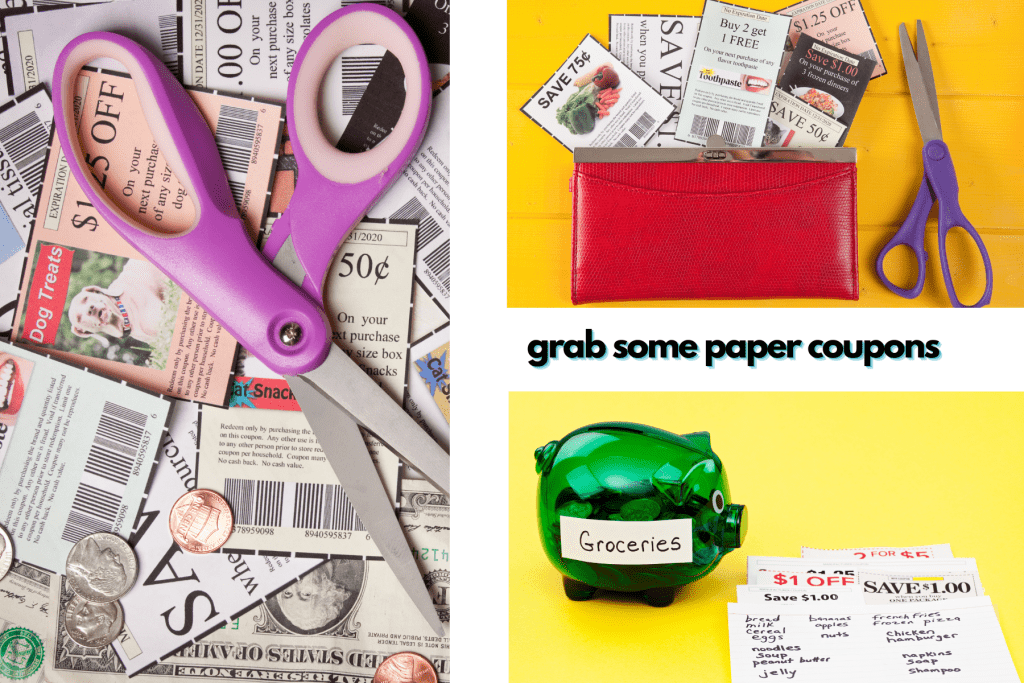
While it’s true, digital coupons and store loyalty cards are popular, there are still some paper coupons available. Although finding these might require that you spend more time searching.
To find some printed coupons, check your grocery in-store ad circular. Here you can find weekly free neighborhood papers that most people just throw out.
Keep in mind you might be able to coupon stack with a printed and digital – what a way to save some hard-earned money!
Check the Clearance Aisle for Deals
Even though scratch ‘n dent items aren’t what they used to be, at different times you can find a particular item that may have been pulled off the shelves.
It might be for the simple fact that the company changed its packaging – but otherwise, it’s fine and in good condition.
In addition, maybe the store just did a reset and has chosen to discontinue that item but still has a full stock of food in it.

To avoid food waste, the store will mark it down making it a great idea to shop sales like these clearance aisle ones.
Also, occasionally things might be getting closer to their expiration date and in need of being marked down.
Keep in mind, if the marked down item is something like dried beans or rice – they have a very long shelf life if stored properly.
After all, they found pasta and rice in the Egyptian pyramids that were still safe to eat in current times.
In addition, some things like rice, sugar, salt, and honey are practically invincible if they are stored correctly.

However, you don’t want to purchase perishables like sour cream for this – stick to non-perishables.
To learn what food items are safe, visit the site Still Tasty – www.stilltasty.com for a good guideline of how safe something is if it is past its expiration date.
Try to Save at Certain Times of the Year
February is national canned food month and offers a ton of incredible sales specials.
In addition, there are often extra coupons to help bulk up your pantry on a budget.
February is the perfect time for those canned meat, beans, vegetables, vegetable juices, fruit, fruit juices, and even canned milk.
Did you miss canned food month?
No worries, things like tuna and canned pasta meals are in that normal store-selling cycle that we already mentioned.

If it isn’t February, look at buying dried beans and lentils instead of the canned kind.
You might find that the price is a lot better, and they will last longer. Also keep in mind that once you cook them, they can be frozen for longer storage.
Buy in Bulk for Great Savings
Whether you are shopping for ground beef, fresh produce, fresh fruits, or fresh ingredients – buying in bulk can really help you save.
Always check the next week’s store ad for store brands as well – these can be great bulk savings.
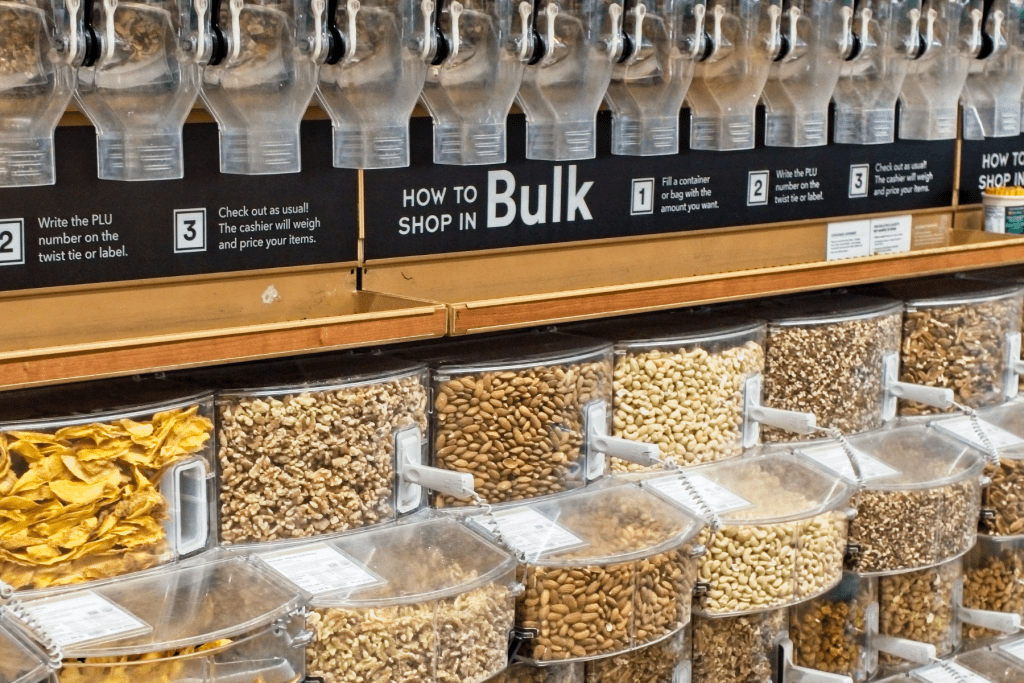
Keep in mind, the price of pre-portioned convenience products can really add up to a much higher price.
Consider that when you look at the cost per ounce on an item, let’s say name brand potato chips, you can buy a full bag, on sale for $3.75, or buy three to four bags at $1.75 a piece.
When you get the single serving packs you can take that large bag and break it down into smaller bags, you will easily have six to eight bags of snacks instead of just three to four.
Now, taking this advice, I am not saying you have to get the jumbo cans of baked beans, but all of those pudding cups, fruit cups, and 4-count cookie packs really charge you for that work of breaking them down.
Learn to Can Your Own Vegetables
If you get free fresh veggies and produce or items from a local farmer and their garden, canning your own vegetables will only take your time – but save a lot of money.
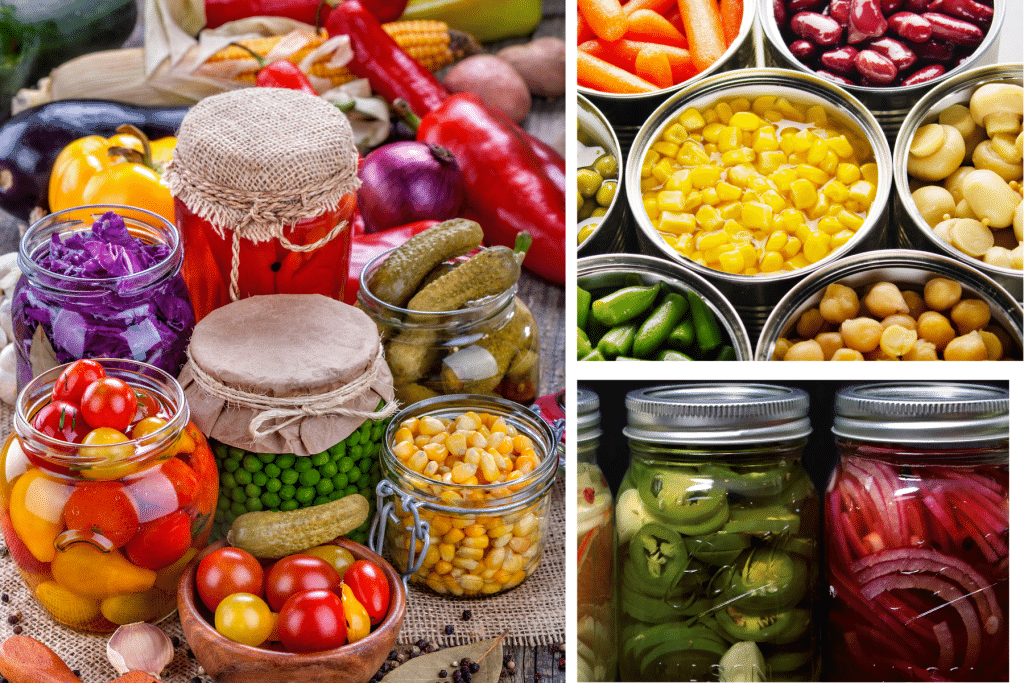
You can save a lot of money on the cost of canning supplies by looking at your local garage sales, thrift stores, or online marketplace groups (if you don’t already have these items).
Never canned before?
No worries! With YouTube videos, you can practically learn just about anything these days – including canning.
Work Your Store Selling Cycle Like a Pro
A great way to get a good deal is to learn about your local grocery store and its selling cycle.
Basically, a selling cycle means that there is a high price and a rock bottom price over a specific period of time.
The trick is to purchase those items (staying within your grocery budget) you want at that low price, and if you can add a coupon to it, even better!
This will save you big on your next shopping trip.
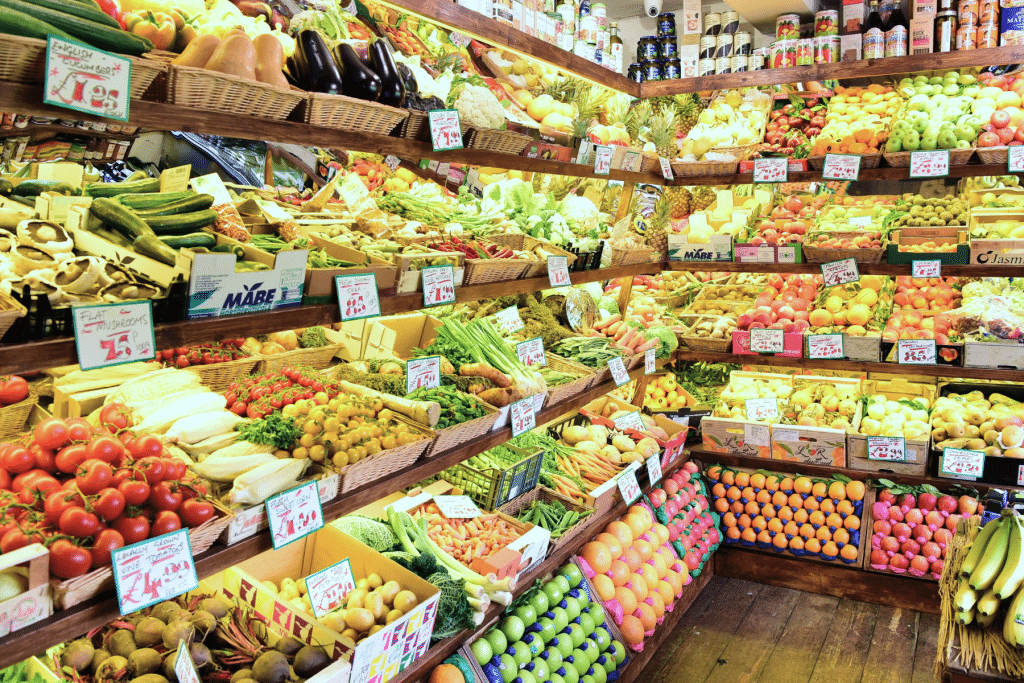
Keep in mind, it can be tricky to figure out your specific store’s cycle.
If you save the weekly sales ads for about two months though, you will clearly see their pattern and figure out how much money you can save.
For example, certain staples like pasta and cereal go on sale every six to eight weeks.
If you watch for that lowest price before you add that item to your shopping list, you will be enjoying these great deals.
You might find the ingredients to make homemade salad dressings on sale at different times as well.

Pro tip: Keep a record of the lowest prices so you know when it’s time to stock up. It is amazing how buying in larger quantities like ten boxes of pasta for a buck each will save you almost ten dollars if you eat a pasta meal every week and it is normally two dollars a box.
In addition, now think of every other pantry staple from canned vegetables to macaroni and cheese, and apply this tip.
You can see how simply working your store’s selling cycle into your tight budget can pay off in the long run.

The first time you add this into your shopping routine it will be your go-to trick for all pasta, grains, ready-to-eat cereal, crackers, cookies, and more.
RELATED POSTS: Need more home help keeping your kitchen and pantry decluttered? Check out Ideas for Storing Your Instant Pot in a Decluttered Kitchen.
For more great DIY and everything home ideas, be sure to follow us on Pinterest, Instagram, Facebook, and Twitter for the latest posts, tips, and ideas.
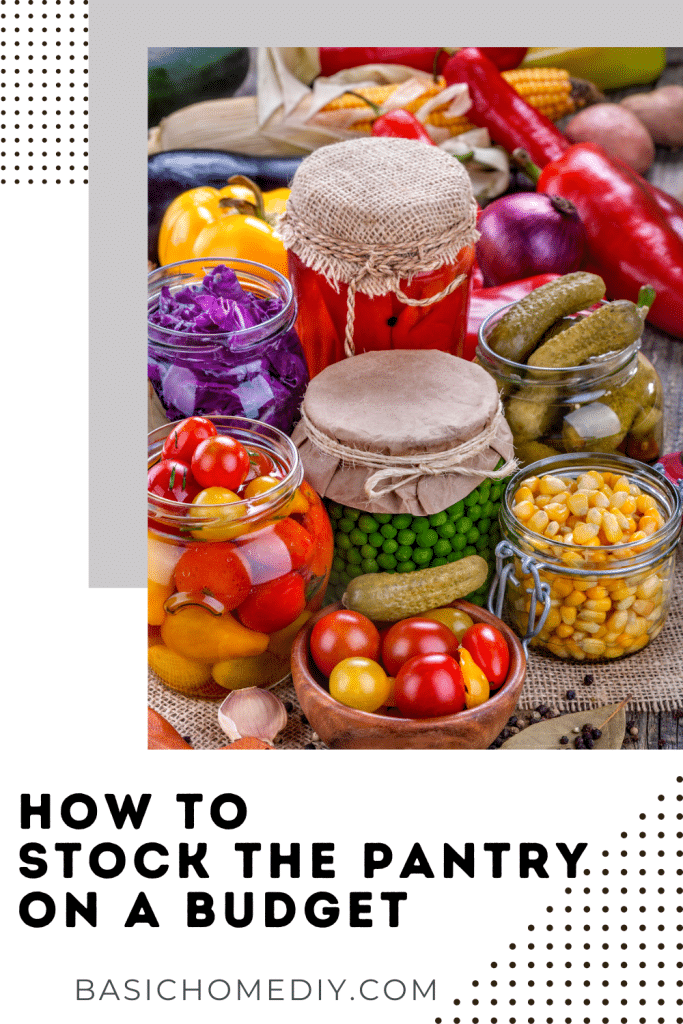
Final thoughts
It really isn’t that difficult to learn the steps of how to stock the pantry on a budget. The most important step is to maintain your stocked pantry shelves once you have the tips and tricks down that we covered in this post.
Your turn
Do you have any tricks on how to stock the pantry on a budget? Do you have any great pantry budget ideas to share? Let me know in the comments!


These are some great ideas. I’ve been thinking of starting to can a bit this summer and maybe start my own garden.
Hi Rae!
I’m glad you liked the tips on how to stock a pantry on a budget. I hope you are able to do some canning this year.
Thank you for reading!
Wow, these are some fantastic suggestions to help with today’s soaring grocery prices. I’ll be starting my own veggie seedlings soon! And yep – I keep a close eye on the clearance aisle. 🙂
Hi Dana!
I’m so excited you liked the tips in the post. The clearance aisle sure has some great deals!
Thank you for reading!
Great tips especially with prices going up everywhere. I like having a stocked pantry just in case plans change and I need to whip up a quick dinner. A lot of people don’t know about the sales cycles and time of year for things to be on sale – and that is a great way to stock up on a great deal!
Hi Morgan!
The sales cycles are a great time to stock up on pantry supplies. It’s always nice to have a stocked pantry just incase!
Thank you for reading!
I have an extremely tight budget these days and this post could not have come at a better time… I like this comment you made ‘fill your pantry with things you will actually eat’ – that is something I definitely have to remember. Great post! Thank you.
Hi Carolyn!
You are very welcome! I’m so glad you found the post helpful!
Thank you for reading!
Great ideas for food shopping. I needed to read an article such as this – I am so bad at planning my shopping trips – thanks for the tips to save a little cash!
Hi Stephanie!
I’m so excited you found the tips on how to stock the pantry on a budget helpful!
Thank you for reading!
This post is so timely with groceries being so expensive right now. Such great tips that k can’t wait to implement in my pantry, which is definitely in need of some TLC!
Hi Valery!
I agree! Things really are very pricey these days! I hope you are able to add some TLC and items to your pantry.
Thank you for reading!
I am always on the lookout for ways to save on my grocery bill – also ideas on what to have in my pantry that won’t sit there for years. Excellent tips I need to follow!
Hi Steph!
I’m excited you found the how to stock the pantry on a budget tips excellent.
Thank you for reading!
I really need to restock -everything in there is probably so old it’s all past the expiration! I’m so bad at that. Also, I didn’t know there was a canned food month! I’m going to have to take some time, clean everything out and start from scratch so I have a pantry I can actually use! Certainly going to use your budgeting tips as man can that get expensive!!!!
Hi Sienna!
I know what you mean about things getting expensive these days. I agree – sometimes it really is best to just go through things and start from scratch.
Thank you for reading!
I love this – great information and ideas! It’s really motivated me to think about how I can do a better job of stocking my pantry and saving money while I do. Thanks for sharing!
Hi Anita!
I’m excited the tips on how to stock the pantry on a budget motivated you to redo yours at home.
Thank you for reading!
These are great tips, thank you for sharing! I have to keep an eye out for February deals now!
Hi Jillian!
I’m excited you found the tips on how to stock the pantry on a budget great! February is a great month to get deals!
Thank you for reading!
I always go with a list to keep from buying things we don’t need. We also try to check the deals for the week and plan meals around that when we can. And digital coupons/cash back apps are amazing!
Hi Stephanie!
Going with a list to the store is so helpful! It really does assist with over-purchasing unnecessary items. I love that tip!
Thank you for sharing and reading!
Thank you for these creative shopping tips. I’m very much interested in canning my own vegetables. It will save me a lot of money.
Hi Beth!
You are very welcome for the tips. Canning your own vegetables really can be such a great way to save money.
Thank you for reading!
Hhhhmmm….I really like your suggestions on this. Given the times we are in, it wouldn’t be bad to stock up on some food!
Hi Ntensibe!
I agree! Having a stocked pantry can be essential with the food prices and inflation!
Thank you for reading!
This posts made me realize I’ve never utilized my pantry to its fullest potential since I’ve moved out on my own. I buy in bulk, but mostly for for the freezer. Thanks for sharing! I’ll definitely remember this!
Hi Whitney!
You are very welcome! I always have a stocked freezer, too! It makes dinner-time easy to prepare.
Thank you for reading!
I love pantries. These are great ideas to take on when on budget, as we need to watch our spending in times like this.
Hi Sonia!
I’m excited you found the ideas on how to stock the pantry on a budget great. I know what you mean about watching a budget in the current times.
Thank you for reading!
Great tips! I have never tried to can my own vegetables, actually never thought of it… I’ll put it on my to-do list 😉
Hi Francesca!
I’m excited you found the how to stock the pantry on a budget tips great! I hope your vegetable canning goes great!
Thank you for reading!
Great idea to focus on foods we like to eat.
As for the dry goods that last forever, can’t forget lentils and legumes! They’re my lifesaver especially on a busy weeknight.
Hi Rekki!
Great tip to add the lentils and legumes! They really are magic on busy nights when preparing dinner.
Thank you for reading!
Our house is small and we don’t have a pantry, so I need these tips. I think I need to make a pantry in the basement!!!
Hi Julie!
I know what you mean about a small home. When we purchased our current home – it didn’t have a pantry. I transformed the coat closet into my kitchen pantry. It’s been so nice. I hope you are able to add one to your home, too.
Thank you for reading!
Buying in bulk provided you have space is a great way to make savings. We do this when we can. Also stocking up on items with long expiration dates is great advice. There are so many different things you can buy. I didn’t realise you could get extra offers in Feb. That’s useful to know.
Hi Melanie!
Buying in bulk is fabulous. But, I agree – finding room can be tricky, especially in a smaller home. We face this challenge often at our current home.
Thank you for reading!
these are some fantastic suggestions, we have been trying to shop the sales for a lot of our items and have noticed we are saving quite a bit by buying a few extra when its on sale.
Hi Tianna!
I’m excited you found the tips fantastic. I agree – sales are fabulous for saving money while begin able to stock the pantry on a budget.
Thank you for reading!
Thank you for these ideas. With the crazy cost of food these days and the amount my kids have been eating, I have been spending way too much on food!
Hi Christina!
You are very welcome! Food really has become expensive and takes up a large portion of family budgets.
Thank you for reading!
It is nice to keep a stocked pantry. These are great tips! I feel like I am always running to the grocery store.
Hi Marysa!
I am excited you found the how to stock the pantry on a budget tips great.
Thank you for reading!
These are such great ideas. Thanks for sharing!
Hi Kirsten!
I’m so glad you found the how to stock the pantry on a budget ideas great!
Thank you for reading!
I need to learn to can vegetables! It’s on my to-do list! It just seems a bit intimidating! Buying from Bulk stores is a great way of saving money and stocking your pantry, but if you bring your own containers to fill, it’s also a very sustainable practice!
Hi Lucie!
Thank you for sharing the great idea to bring your own refillable containers for sustainable practice. That’s a perfect idea!
Thank you for reading!
Great detailed information! Since I live in Florida and deal with hurricanes, I have the motto-“Buy one…save one.”
Hi Shelly!
Thank you for sharing the perfect tip for fellow Floridians in the hurricane zone! Having a stocked pantry is definitely essential during difficult weather!
Thank you for reading!
It’s always good to prepare everything beforehand and have a list when you are finally going grocery shopping. Those are some great tips to keep in mind as well.
Hi Angela!
Great tip to keep a list before going grocery shopping. It really does help you purchase just what is needed and stay within a budget to stock the pantry.
Thank you for reading!
This is such a helpful post. I need to cross-check the list against what I’ve got and fill the gaps!
Hi there!
Perfect idea to keep checking the list to not over- or -under purchase items.
Thank you for reading!
It’s so important to be stocked up I appreciate the tips on finding deals and saving money and time!
Hi Natalie!
I agree! Keeping a stocked pantry is essential – especially when there are great deals and sales!
Thank you for reading!
Such great tips! Coupons i have never done but will get into it. Thanks.
Hi Amadna!
Couponing is a great way to stock the pantry on a budget. It can take some time to organize but well worth the effort.
Thank you for reading!
It’s good to pay attention to sales and things that you can use to save money. Very informative!
Hi Fransic!
I’m excited you found the post on how to stock the pantry on a budget informative. Sales really are great to save money, too!
Thank you for reading!
I had no idea February was national canned food month!
I never got into couponing but I am interested in how to set realistic goals with this to slash my pantry budget.
Hi LG!
Setting realistic goals to keep your pantry budget in check is such a great idea.
Thank you for reading!
Great suggestions! Will definitely keep these tips in mind.
Hi Mustafa!
I’m excited you found the suggestions on how to stock the pantry on a budget to be great.
Thank you for reading!